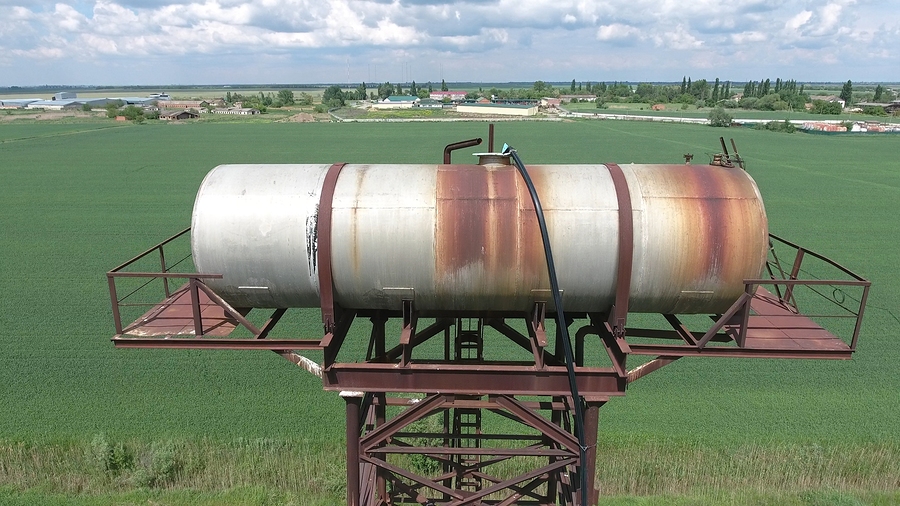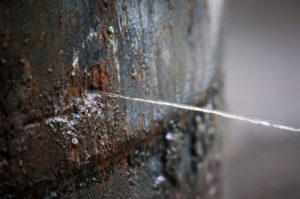Aboveground storage tank leaks, spills, and failures are costly events that can be disastrous for tank owners and plant employees as well as the surrounding environment and population. According to the National Association for Corrosion Engineers (NACE), leaking tanks can “lead to billions of dollars in direct and indirect costs.”
Be proactive when maintaining your aboveground storage tanks: Address potential leak spots and mitigate risks before problems occur. The first step is to clearly understand what causes leaks and the second is to learn how to best prevent them moving forward.

Aboveground storage tanks are known to leak if one or more of the following conditions applies:
- Poor tank design — When designing aboveground storage tanks, keep in mind the materials you’ll be holding within those tanks. Fabricating tanks using the wrong materials or even designing them using incorrect shapes can have serious consequences, including loss of structural integrity resulting in leaks or worse.
- Changes to tank pressure — Tanks are meant to safely hold materials at certain pressure levels and temperatures. If tank vents become blocked or the temperature surrounding the tank changes rapidly, serious failure can occur. In some cases, these conditions create vacuums, which can cause tanks to implode.
- Operator errors — Sometimes, lack of proper training or employee preparedness can result in tank leaks. This can include operators overfilling tanks, failing to properly inspect and maintain tanks, as well as missing signs of potential problem areas, actual leaks, or imminent failures.
- Tank or piping corrosion — Corrosion is a major culprit for tank leaks and failures. As previously mentioned, the contents held within a tank must be stored using the proper tank materials. Many of the materials tanks hold are highly abrasive and corrosive by nature. They can eat away at tanks over time, causing leaks and even tank failures. The bottoms of tanks are particularly high risk corrosion areas. When pipes become corroded, they too lose their integrity and are at risk for leaking.
Tank owners and operators can mitigate these risks through proper design, maintenance, and repair measures to uphold tank integrity. Failure to take such preventive measures can come at great expense.
Tank leak prevention
 Leaks and spills will likely have, at the very least, some negative environmental impacts on the soil, air, wildlife, and potentially groundwater or water sources near the tanks. Worse yet, tank failures can be deadly to personnel and nearby residents. Tank owners may be liable for the cleanup and damages spills cause and can also face penalties if their companies are found negligent. Tank leaks and spills can quickly become damaging and costly: It’s best for all when you take steps to avoid the root causes of leaks at all costs.
Leaks and spills will likely have, at the very least, some negative environmental impacts on the soil, air, wildlife, and potentially groundwater or water sources near the tanks. Worse yet, tank failures can be deadly to personnel and nearby residents. Tank owners may be liable for the cleanup and damages spills cause and can also face penalties if their companies are found negligent. Tank leaks and spills can quickly become damaging and costly: It’s best for all when you take steps to avoid the root causes of leaks at all costs.
Regular tank maintenance and stewardship is the best way to prevent leaks, spills, and failures. Other leak prevention tactics include investing in high quality tank design and fabrication with appropriate materials and measures to properly vent the tanks. According to the NACE article, “without implementation of appropriate corrosion control measures, storage tanks will deteriorate.” Secondary containment and corrosion resistant liners significantly reduce corrosion risks and help protect tank integrity.
Perform regular tank inspections to detect signs of tank leaks before they become full blown failures. Tank maintenance should include repairing any corrosion, welding failures, or any other areas that may eventually leak. Tank operators should also ensure they keep vents clear of debris to maintain proper tank pressures.
